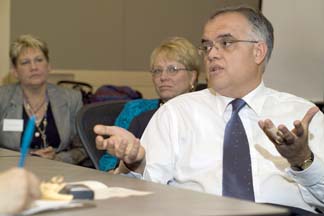Panel discusses sustainable development in Southeastern Anatolia
By Theresa Jeanine D'Andrea

Turkey's geo-politically vital and rich cultural region of Southeastern Anatolia is undergoing massive changes. Water resources management is one of the top development issues facing the region. Some 13 major water projects are under way in the area, but they represent only one component of Southeastern Anatolia's complex development issues.
"It's [the development] really to change the region and focus on sustainable regional, economic, human and social development," said Peter Loucks, Cornell University professor of Civil and Environmental Engineering, during introductory comments at a Sept. 30 forum, "Development Issues in Southeastern Anatolia, Including GAP (the Southeastern Anatolia Project)," held in the Ives Hall Conference Center. The panel discussion was part of "Turkey: Culture, Change and Development," a weeklong presentation by the Mediterranean Initiative of Cornell's Institute for European Studies and International Programs of the College of Agriculture and Life Sciences.
GAP is a massive $32 billion public project to harness the power and potential of the upper reaches of the Tigris and Euphrates rivers and to irrigate the fertile plains that lie between them, according to the project Web site. When completed in 2010, 21 dams and 17 hydroelectric power plants will produce approximately 22 percent of Turkey's projected electricity requirements. The project uses water as an engine that drives social, economic and human development. Until recently the area was known as "the forgotten Turkey" because it was underdeveloped and isolated from the more modern urban centers of western Turkey. It borders on Iraq and Syria, making it a strategically important area as well.
Three speakers affiliated with GAP addressed sustainability issues in Turkey, including Olcay Unver, visiting distinguished professor at Kent State University and former president of GAP.
"In the coil of the project," Unver said, "there is a heavy water resources development program with seven clusters of water projects in the Euphrates River and six in the Tigris River, corresponding to 22 dams, 19 hydropower plants, 1.7 million acres of land and the generation of 27 billion kilowatt hours. The water component is really substantial." He went on to say that GAP anticipates gross regional production to increase by 445 percent, per capita income to increase by 209 percent and job opportunities to be created for 4 million people. More than half of the irrigation projects are in the preconstruction phase, and only 13 percent are operational now. In the hydropower sector, the physical completion rate is 73 percent with only 19 percent in the preconstruction phase.
"Already $17 billion has been invested," Unver said. "With that, the project is already paying back. The hydropower plants alone for a typical year, which was 2003 in this case, produced energy equivalent to $919 million."
Linda Robertson, director of the Gerald Read Center for International and Intercultural Education at Kent State University, said that the GAP administration understands the importance of social capital development and in 2001 had sponsored training in social capital and the regional development project. GAP employees were taught about the social capital in Southeastern Turkey, which encompasses the interpersonal relations of the various heritages in the region, the interpersonal interactions found in gender differences and the disparity of socio-economic roles as they apply to interpersonal interactions.
"Instead of bridging ethnic differences and creating new kinds of working relationships which you want in development, the internal social cohesion makes it difficult to break down the ethnic group attachments and it results in conflict," Robertson said. "Then, intercultural communication training becomes vital. The first project by GAP was to offer the intercultural training workshops. This was a train-the-trainer model, and it concentrated on Turkish-specific training material based on and written by people in the GAP region."
Another social development in the GAP region is the Turkish Women's Leadership Project. Multipurpose community centers, or CATOM, were created for women. These CATOMs provide literacy, medical, social and income generation activities for women and children in villages and urban centers in over 30 areas of Southeastern Turkey. CATOM committees are elected by the members and they become the governing board, representing a trend toward democracy, Robertson said.
Jeni Grossman, a writer working with GAP, described the importance of Southeastern Anatolia culture.
"How can we understand the world unless we understand Southeast Turkey?" Grossman asked. "Biblical Abraham was born in Ur, which I believe was in Turkey. The sibling rivalry between Abraham's children, Isaac and Ishmael, is still going on today between different religious groups in the area. Southeast Turkey is also where Christianity began. The apostle Paul had three missionary journeys all throughout Southeast Turkey, and the first time someone was called a Christian was in Antioch, Turkey."
Grossman spoke also about Zeugma. "Most of the world does not know about this but this will be the next Pompeii. Zeugma is so rich with art and artifacts that it will be a world-class destination. It was the largest Roman legion outpost with 70,000 residents living on the banks of the Euphrates about 2,000 years ago."
Media Contact
Get Cornell news delivered right to your inbox.
Subscribe